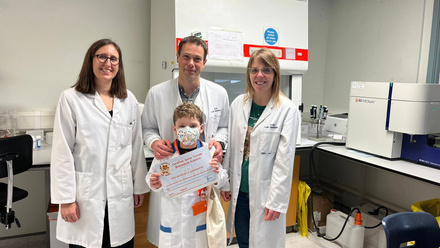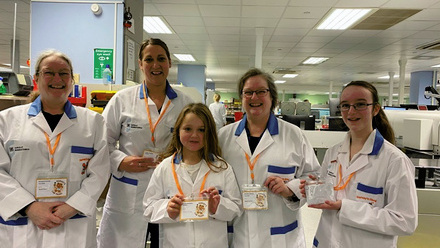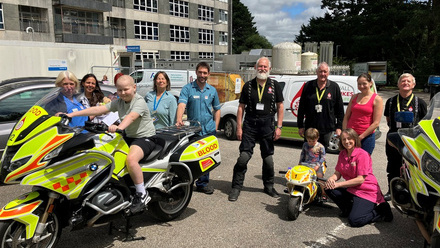Inside GOSH: Rachel Moss on Inspiring Patients
We chatted with Rachel Moss, Advanced Transfusion Practitioner at Great Ormond Street Hospital (GOSH), about her work with Harvey’s Lab Tours and the progress she has seen since the site first got involved in 2016.
How did you go about planning your first Harvey’s Lab Tour?
Our first visitor was a five year old who was completely needle phobic, and we were asked to facilitate a visit to the labs. We contacted Malcolm Robinson (founder of Harvey’s Lab Tours) who kindly sent everything we needed for our first tour. After this first visit we involved our Infection Control Team to help us design the required questions for clinical colleagues to complete when they wanted one of their patients to visit, so both patients and staff were kept safe.
We then advertised the lab tours on the hospital intranet as a behind the scenes look into the Haematology, Coagulation and Blood Transfusion Laboratories, showing how analysers work, looking down microscopes, learning about blood cells, and seeing the blood stored in the Blood Bank.
What do you think makes a good lab tour for a young patient?
Rachel believes a good tour should always be fun. At Great Ormond Street Hospital, the team include experiments that never fail to engage young visitors:
- Dry ice and washing-up liquid in a bowl or bucket, creating an eruption of bubbles.
- Filling the test tube using coloured water and pipettes to fill to a line they've marked.
- If you have access to an analyser with a robot arm in the Transfusion Laboratory, this always intrigues visitors (they may need a way of seeing it up close whilst making sure health and safety is not compromised).
- The microscope is a winner, especially if you have slides with frogs blood or chicken skin as well as blood cells. Kids do love the unusual!
How important is teamwork across departments when delivering a tour?
This needs total cooperation from everyone.
Laboratory Managers need to support the tours so that a Biomedical Scientist can be released from the bench.
The Biomedical Scientist who leads the tour must understand how to talk to the young visitors and be able to gauge their level of understanding and how the child is managing the visit. A less well child may tire more easily and need a seat, an anxious child may find the lab noises distracting, whereas a more active child may need activities to help them focus rather than just looking around.
The Biomedical Scientist leading the tour needs to know how to communicate with children, gauge their level of understanding and how they are managing the visit. Is it important they can recognise when the child might be tired or anxious, and adjust accordingly
Other laboratory colleagues need to be aware when we have a young visitor, so that conversations about other patients are not done close by.
Parents or carers must also understand that a lab is an adult work environment, not child-friendly like the wards, so they need to be confident their child can manage the visit.
We will not allow a lab tour without a responsible adult for the young visitor. This can be a healthcare professional from the clinical team, or a parent/carer.
What kind of preparation happens behind the scenes to make a tour run smoothly?
Every tour request is carefully reviewed based on the child’s age, diagnosis, and reason for visiting the hospital. We currently only do haematology, coagulation and blood transfusion lab tours, so our areas need to be relevant to their care.
The clinical team completes a pre-questionnaire stating if the patient is immunocompromised, and their infection status, including any diarrhoea or vomiting. The patient must be well to visit. We can always defer to another day if necessary.
Once we know who they are, we build them a goody bag, get the correct sized lab coat, make them a personalised ID badge and a certificate.
What challenges did you face getting started, and how did you overcome them?
It took some time to get the Infection Control Team to agree. They had concerns about having children in the labs, and we had to show that each case would be carefully screened and supervised.
At first, we also struggled to find lab coats and goody bag materials. But now that the IBMS supports Harvey’s Lab Tours, it’s much easier to access what we need.
What’s one thing you’ve learned from Harvey’s Lab Tours?
We have some brilliant Biomedical Scientist staff who have led the visits. Their engagement with the children and their families, the explanations of what happens in a lab and doing the experiments has been amazing. We also know that the parents, and any clinical staff that come along too, absolutely love it. Patients are the reason we do the jobs we do, and bringing them into our laboratory world really helps cement that fact.
What’s been the most rewarding part of getting involved?
The dry ice and bubbles has guaranteed squeals of fun from our young visitors, to the point where we had to calm things down as the emergency phone was ringing in the Transfusion lab!
The team at GOSH received this feedback from another family:
Thank you so much for organising the trip to the lab for M & N. They had a fantastic time and I was so thrilled to see them engaged and fascinated. Truly a treat for me as a mother to see. M & N were wearing their lab coats all evening yesterday. M told everyone about the experience and was very excited by the goodies in the bag. Please convey my gratitude to Rachel and her team.
Do you have any tips for other labs thinking of starting their own tour?
Find a team of Biomedical Scientists that are keen. Once they have each done a couple of visits they will get into a ‘lab tour routine’. They will get a feel for communicating with young visitors and will begin to anticipate some of the frequent questions. They can also rotate, which means it isn’t all on one person. Not everyone feels comfortable with young patients, so really support those who volunteer to do the visits.
Keep a communal spreadsheet of who is booked in, when and who will do the visit. Realistically, one or two a month is all we can do at Great Ormond Street, as it does take a BMS off the bench.
Have a point of contact for the wards. The Transfusion Practitioner is ideal.
Make sure everyone knows about them. Have stands in the canteen, promote at trust events, do a poster for trust-based conferences. The teams that contact us the most are the Clinical Psychologists, to support patients who struggle with blood tests, and our Clinical Nurse Specialist teams who feel a visit to the labs will help the patient better understand their treatment.
We would like to thank Rachel and the wider Great Ormond Street Hospital team for their long-standing commitment to Harvey’s Lab Tours and for inspiring so many young patients over the years. If you’re thinking about getting involved or introducing lab tours to your site, contact [email protected] to find out how you can get started.





